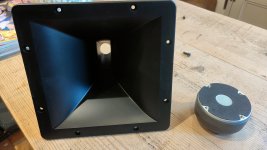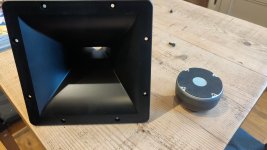Very much home/hifi and not PA. Modest size UK room. 3m listening distance or so
Thanks. And can I ask again what may a passive XO look like.? As regards flattening the response.
For a constant directivity up to 15kHz check the ATH A460D variant.
- https://at-horns.eu/A460D.html
But that has not yet been measured with the DFM 2335.
- https://at-horns.eu/A460D.html
But that has not yet been measured with the DFM 2335.
The polars as shown by miero above have a nice natural fall with frequency along with increasing DI. Sometimes that sounds OK as is. On the other hand the direct answer to your question probably involves a series resistor with a capacitor across it.Thanks. And can I ask again what may a passive XO look like.? As regards flattening the response.
I got confused by incorrect model number in the thread subject. There are measurements of A460D with DFM 2353.But that has not yet been measured with the DFM 2335.
- https://www.diyaudio.com/community/...-design-the-easy-way-ath4.338806/post-7826267
Last edited:
For that one I'd begin with an L-pad to help with the impedance, a notch filter around 3kHz and second order high pass... just to show what could be done. The real crossover would likely be more involved.
I got confused by incorrect model number in the thread subject. There are measurements of A460D with DFM 2353.
- https://www.diyaudio.com/community/...-design-the-easy-way-ath4.338806/post-7826267

@AllenB
Would you kindly change the title of this thread to 2535?
Thanks in advance
Very much home/hifi and not PA. Modest size UK room. 3m listening distance or so
If you are referring to SPL, I agree that 111dB/1m is a bit limited for PA. For a small solo singer/guitarist in a cafe it’s perhaps ok.
For home hifi, single unit just meets THX/Atmos spec for 85dB at -20dBFS @2m
For larger spaces and listening at 8+ metres, an extra 10dB would be welcome.
I can start to see why PA line arrays have supplanted point sources for large venues Eg. Stadiums
Last edited:
Attachments
F6- terminus/mouth/baffle size:
F6- = 10^6/(baffle*wall angle) inches
F6- = (2.54*10^6)/(baffle*wall angle) cm
The higher the aspect ratio (taller) the wider its horizontal polar response and vice versa.
F6- = 10^6/(baffle*wall angle) inches
F6- = (2.54*10^6)/(baffle*wall angle) cm
The higher the aspect ratio (taller) the wider its horizontal polar response and vice versa.
@tktran303: Are these H250 measurements made with horn on infinite baffle or in a cabinet with rounded edges around the horn?
I was just curious about if the dips in the 1.5kHz region are due to the waveguide 'termination' issue or something else..
I was just curious about if the dips in the 1.5kHz region are due to the waveguide 'termination' issue or something else..
Free standing
ie. CD screwed to horn and then horn placed on turntable to take measurements.
ie. CD screwed to horn and then horn placed on turntable to take measurements.
- Home
- Loudspeakers
- Multi-Way
- Tymphany DFM-2535-R00-08 in SB Audience H225 90x60 degree constant directivity horn



